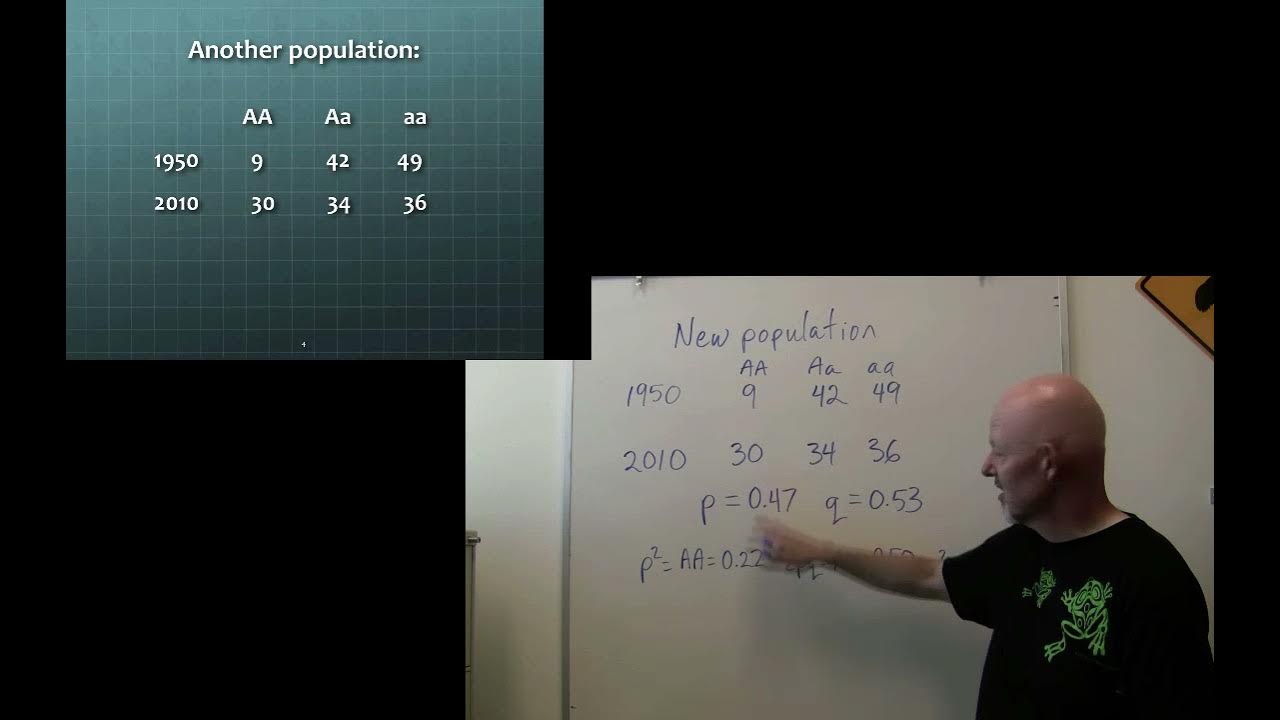Discussions of conditions for Hardy Weinberg | Biology | Khan Academy
Summary
TLDRThe video delves into the Hardy-Weinberg equation, outlining the conditions necessary for stable allele frequencies in a population. It explains how allele frequencies for traits, such as eye color, can be predicted under the assumption of no evolution, no selection, no genetic drift, and random mating. The model's applicability to diploid organisms and sexual reproduction is emphasized, along with its limitations in real-world scenarios where evolutionary forces are at play. Overall, it serves as a foundational concept in understanding population genetics and the dynamics of allele variation.
Takeaways
- 😀 The Hardy-Weinberg equation describes genetic variation in a population at equilibrium using allele frequencies.
- 🔄 The equation can be expressed as p² + 2pq + q² = 1, where p and q represent the frequencies of two alleles.
- 🛑 Stable allele frequencies indicate no evolution is occurring within the population.
- 🌍 Key conditions for Hardy-Weinberg equilibrium include no selection, no genetic drift, no mutation, random mating, and no migration.
- ⚖️ No selection means that advantageous traits do not affect survival and reproduction rates.
- 🎲 Genetic drift refers to random changes in allele frequencies, which are more significant in small populations.
- 🔬 No mutation ensures that new alleles do not change the existing allele frequencies within the population.
- ❤️ Random mating implies that mate selection does not favor specific alleles, promoting a random combination of alleles.
- 🚫 No migration prevents changes in allele frequencies due to individuals entering or leaving the population.
- 🔍 Although few populations meet all Hardy-Weinberg conditions, the equation provides a valuable approximation for understanding genetic structure and evolution.
Q & A
What is the Hardy-Weinberg equation used for?
-The Hardy-Weinberg equation is used to describe the genetic variation in a population at equilibrium, focusing on allele frequencies of traits, such as eye color.
What conditions must be met for the Hardy-Weinberg equation to hold?
-The conditions include no selection, no genetic drift, no net mutation, random mating, and no migration, all contributing to stable allele frequencies.
How are allele frequencies represented in the Hardy-Weinberg equation?
-In the equation, 'p' represents the frequency of one allele (e.g., blue) and 'q' represents the frequency of the other allele (e.g., brown). The sum of p and q equals 1.
What is the significance of a stable allele frequency?
-A stable allele frequency indicates that there is no evolution occurring in the population, meaning the inheritable traits are not changing over time.
What role does genetic drift play in the Hardy-Weinberg equilibrium?
-Genetic drift can cause random changes in allele frequencies, especially in small populations, potentially leading to deviations from Hardy-Weinberg expectations.
What is meant by 'no selection' in the context of Hardy-Weinberg?
-No selection means that individuals with different alleles have equal fitness, so the allele frequencies are not influenced by advantageous or disadvantageous traits.
Why is large population size important for Hardy-Weinberg equilibrium?
-Large populations minimize the impact of genetic drift, making it less likely that random events will significantly alter allele frequencies.
What assumption is made regarding the mating of organisms in Hardy-Weinberg?
-The assumption is that mating is random, meaning that the presence of a particular allele does not influence mate selection.
What types of reproduction are assumed in the Hardy-Weinberg model?
-The model assumes sexual reproduction in diploid organisms, where alleles are inherited from both parents.
Are there real populations that meet all the Hardy-Weinberg assumptions?
-In reality, very few populations meet all the Hardy-Weinberg assumptions, but the model serves as a good approximation for many populations in practice.
Outlines

Этот раздел доступен только подписчикам платных тарифов. Пожалуйста, перейдите на платный тариф для доступа.
Перейти на платный тарифMindmap

Этот раздел доступен только подписчикам платных тарифов. Пожалуйста, перейдите на платный тариф для доступа.
Перейти на платный тарифKeywords

Этот раздел доступен только подписчикам платных тарифов. Пожалуйста, перейдите на платный тариф для доступа.
Перейти на платный тарифHighlights

Этот раздел доступен только подписчикам платных тарифов. Пожалуйста, перейдите на платный тариф для доступа.
Перейти на платный тарифTranscripts

Этот раздел доступен только подписчикам платных тарифов. Пожалуйста, перейдите на платный тариф для доступа.
Перейти на платный тариф5.0 / 5 (0 votes)






